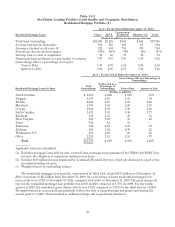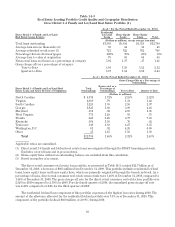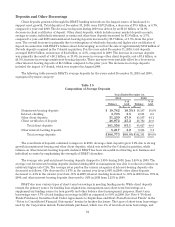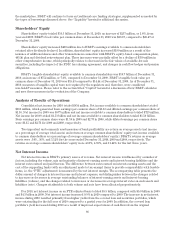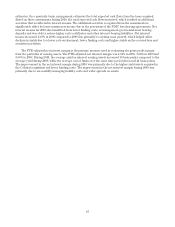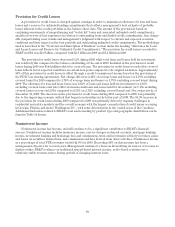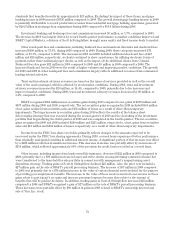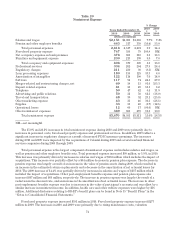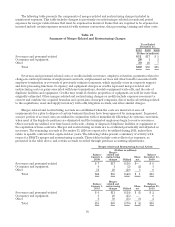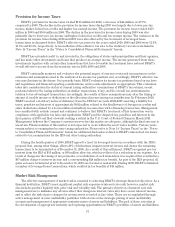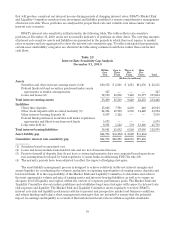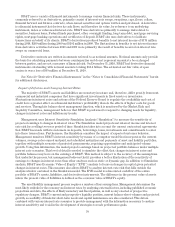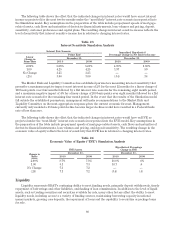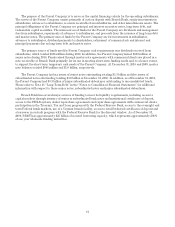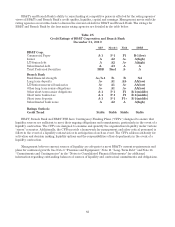BB&T 2010 Annual Report Download - page 72
Download and view the complete annual report
Please find page 72 of the 2010 BB&T annual report below. You can navigate through the pages in the report by either clicking on the pages listed below, or by using the keyword search tool below to find specific information within the annual report.standards that benefited results by approximately $23 million. Excluding the impact of these items, mortgage
banking income in 2009 increased $356 million compared to 2008. The growth in mortgage banking income in 2009
is primarily attributable to record production revenues from residential mortgage banking operations, generated
by $28.2 billion in mortgage loan originations during 2009 compared to $16.4 billion during 2008.
Investment banking and brokerage fees and commissions increased $6 million, or 1.7%, compared to 2009.
The increase in 2010 was largely driven by record fourth quarter performance as market conditions improved and
BB&T Capital Markets, a division of Scott & Stringfellow, brought more equity and fixed income deals to market.
Other nondeposit fees and commissions, including bankcard fees and merchant discounts and checkcard fees
increased $109 million, or 17.8%, during 2010 compared to 2009. During 2009, these categories increased $71
million, or 13.1%, compared to 2008. The increases in 2010 and 2009 included additional checkcard fees of $47
million and $26 million, respectively, as clients continued to show a preference for utilizing electronic forms of
payment rather than traditional paper checks, as well as the impact of the additional clients from Colonial.
Bankcard fees also grew $21 million in 2010 compared to 2009 and $5 million in 2009 compared to 2008. The
increased bankcard fees in 2010 were the result of higher volumes and improving market conditions. The growth
for 2010 and 2009 in other nondeposit fees and commissions largely reflects additional revenues from commercial
lending-related activities.
Trust and investment advisory revenues are based on the types of services provided as well as the overall
value of the assets managed, which is affected by stock market conditions. During 2010, trust and investment
advisory revenues increased by $20 million, or 14.4%, compared to 2009, primarily due to fee increases and
improved market conditions. During 2009, trust and investment advisory revenues decreased by $8 million, or
5.4%, compared to 2008.
BB&T recognized $554 million in net securities gains during 2010 compared to net gains of $199 million and
$107 million during 2009 and 2008, respectively. The net securities gains recognized in 2010 included $585 million
of net gains realized from securities sales and $31 million of losses as a result of other-than-temporary
impairments. The large increase in securities gains during 2010 reflects the results of the balance sheet
deleveraging strategy that was executed during the second quarter of 2010 and the de-risking of the investment
portfolio that began during the third quarter of 2010 and was completed in the fourth quarter. The net securities
gains recognized in 2009 and 2008 included $240 million and $211 million, respectively, of net gains from securities
sales and $41 million and $104 million of losses, respectively, as a result of other-than-temporary impairments.
Income from the FDIC loss share receivable primarily reflects changes to the amounts expected to be
recovered under the FDIC loss sharing agreements. During 2010, covered loans experienced better performance
than originally anticipated resulting in additional interest income. A significant portion of that increase was offset
by a $232 million reduction in noninterest income. This decrease in income was partially offset by an increase of
$116 million, which reflected approximately 80% of the provision for credit losses recorded on covered loans.
Other income, including income from bank-owned life insurance, decreased $122 million in 2010 compared to
2009, primarily due to a $90 million increase in losses and write-downs on nonperforming commercial loans that
were transferred to the loans held for sale portfolio in connection with management’s nonperforming asset
disposition strategy. Trading gains at Scott & Stringfellow declined $25 million. Also, the prior year included a
$27 million gain on the sale of BB&T’s payroll processing business. The increase of $57 million in 2009 compared
to 2008 was primarily due to a $74 million increase in the value of various financial assets isolated for the purpose
of providing post-employment benefits. The increase in the value of these assets is neutral to net income as these
gains relate to participant’s accounts and increase personnel expense because they relate to the amount of
benefits that will be paid in the future. In addition, trading gains at Scott & Stringfellow increased $25 million
compared to 2008 and BB&T recognized a gain of $27 million on the sale of BB&T’s payroll processing business.
These increases were partially offset by $80 million in gains in 2008 related to BB&T’s ownership interest and
sale of Visa, Inc. stock.
72


